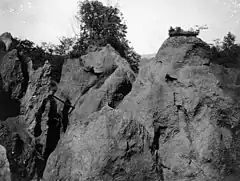| Tomstown Dolomite | |
|---|---|
| Stratigraphic range: Cambrian | |
 USGS photo 1 mile east of Bakerton, West Virginia | |
| Type | Sedimentary |
| Underlies | Rome Group and Waynesboro Formation |
| Overlies | Antietam Formation and Chilhowee Group |
| Thickness | 200 - 1000 feet |
| Lithology | |
| Primary | dolomite |
| Other | Chert, limestone, shale |
| Location | |
| Region | Appalachia, Mid-Atlantic United States, and Southeastern United States |
| Country | United States |
| Extent | Maryland, Pennsylvania, Virginia,[1] West Virginia |
The Tomstown Dolomite or Tomstown Formation is a geologic formation in Maryland, Pennsylvania, Virginia and West Virginia.[2][3][4] It preserves fossils dating to the Cambrian Period.
In Maryland it is described as "Interbedded light gray to yellowish-gray, thin- to thick-bedded dolomite and limestone; some shale layers; gradational contact with Antietam; thickness 200 to 1,000 feet."[2]
See also
References
- Various Contributors to the Paleobiology Database. "Fossilworks: Gateway to the Paleobiology Database". Retrieved 17 December 2021.
This article is issued from Wikipedia. The text is licensed under Creative Commons - Attribution - Sharealike. Additional terms may apply for the media files.